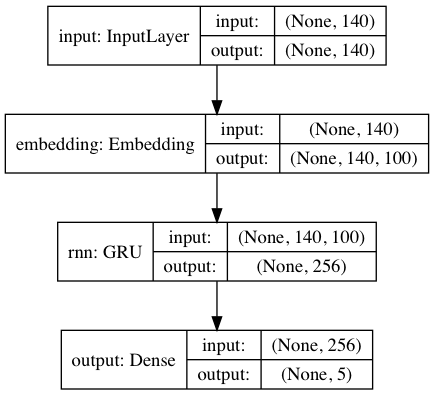minimaxir / Reactionrnn
Projects that are alternatives of or similar to Reactionrnn
reactionrnn
reactionrnn is a Python 2/3 module + R package on top of Keras/TensorFlow which can easily predict the proportionate reactions (love, wow, haha, sad, angry) to a given text using a pretrained recurrent neural network.
from reactionrnn import reactionrnn
react = reactionrnn()
react.predict("Happy Mother's Day from the Chicago Cubs!")
[('love', 0.9765), ('wow', 0.0235), ('haha', 0.0), ('sad', 0.0), ('angry', 0.0)]
Unlike traditional sentiment analysis models using tools like word2vec/doc2vec, reactionrnn handles text at the character level, allowing it to incorporate capitalization, grammar, text length, and sarcasm in its predictions.
> react.predict("This is scary AF!😱😱")
[('wow', 0.9109), ('sad', 0.0891), ('love', 0.0), ('haha', 0.0), ('angry', 0.0)]
> react.predict("When the soup is too hot 😂😂😂")
[('haha', 0.8568), ('love', 0.1376), ('wow', 0.0056), ('sad', 0.0), ('angry', 0.0)]
> react.predict("He was only 41.")
[('sad', 1.0), ('love', 0.0), ('wow', 0.0), ('haha', 0.0), ('angry', 0.0)]
> react.predict("Everyone loves autoplaying videos!")
[('angry', 0.8667), ('wow', 0.1333), ('love', 0.0), ('haha', 0.0), ('sad', 0.0)]
As a bonus, the model can encode text as a 256D vector (incorporating grammar/caps/length/punc) which can then be fed into other machine learning/deep learning models.
> react.encode("DYING. 😄")
[ 0.0411452 0.87985831 0.31406021, ...]
Did I mention that reactionrnn is also available as an R package with feature parity?
library(reactionrnn)
react <- reactionrnn()
react %>% predict("Happy Mother's Day from the Chicago Cubs!")
love wow haha sad angry
0.97649449 0.02350551 0.00000000 0.00000000 0.00000000
Usage
For Python, reactionrnn can be installed from pypi via pip:
python3 -m pip install reactionrnn
You may need to create a venv (python3 -m venv <path>) first.
For R, you can install reactionrnn from this GitHub repo with devtools (working on resolving issues to get package on CRAN):
# install.packages('devtools')
devtools::install_github("minimaxir/reactionrnn", subdir="R-package")
You can view a demo of common features in this Jupyter Notebook for Python, and this R Notebook for R. (full documentation coming soon)
Neural Network Architecture and Implementation
reactionrnn is based off of the June 2016 blog post I wrote titled Classifying the Emotions of Facebook Posts Using Reactions Data, which noted that there is a certain nuance to the proportionality of the reactions on a Facebook status. What makes a Facebook post "WOW" but not "HAHA"? Is there a semantic difference between a post with 75% SAD and 90% SAD? A year later, Facebook now has enough public data to sufficiently train a neural network to understand these nuances.
reactionrnn takes in an input of up to 140 characters (for compatability with Twitter tweets), converts each character to a 100D character embedding vector, and feeds those into a 256-cell gated recurrent unit layer. That output regresses the five non-Like Reactions all simultaneously and outputs the predicted proportionality values for each; predicted values will always sum to 1 (unlike Google's Perspective API, the output is not the probability of the label as is the case with a classification model!)
The 1.3MB model weights included with the package are trained on the captions on hundreds of thousands of public Facebook statuses on Facebook Pages (via my Facebook Page Post Scraper), from a very diverse variety of subreddits/Pages (which is necessary since some Pages will have very different reactions to a given text!). The network was also trained in such a way that the rnn layer is decontextualized in order to both improve training performance and mitigate authorial and temporal biases toward given reactions.
The encode function of reactionrnn returns the intermediate 256D output from the 'rnn' layer.
Notes
-
Keep in mind that the network is trained on modern (2016-2017) language. As a result, inputting rhetorical/ironic statements will often yield love/wow responses and not sad/angry.
-
If a text sequence is >140 characters, reactionrnn will only use the first 140 characters.
-
If you do use
encodeon multiple texts, I strongly recommend using principal component analysis to both reduce the high dimensionality of the text (i.e to 30-50D) and align the returned encoded texts. (see reactionrnn demos on how to implement PCA in Python and R) -
A GPU is not required to use reactionrnn.
Future Plans for textgenrnn
-
A web-based implementation using Keras.js (works especially well due to the network's small size)
-
A larger pretrained network which can accommodate longer character sequences and a more indepth understanding of language, creating better/more robust reaction predictions. This may be released as a commercial product instead, if any venture capitalists are interested.
Maintainer/Creator
Max Woolf (@minimaxir)
Max's open-source projects are supported by his Patreon. If you found this project helpful, any monetary contributions to the Patreon are appreciated and will be put to good creative use.
Disclaimer
reactionrnn is not supported by nor endorsed by Facebook.
License
MIT

